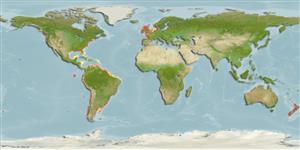Common names from other countries
Environment: milieu / climate zone / depth range / distribution range
экология
; пределы глубины 0 - 30 m (Ref. 87801). Tropical; 62°N - 45°S, 137°W - 177°E
Atlantic Ocean, Pacific Ocean, Mediterranean and the Black Sea. Introduced in Australia and southwest Atlantic.
Length at first maturity / Size / Вес / Возраст
Maturity: Lm ? range ? - ? cm
This suspension feeder is found on algae, hard and soft bottoms at depths of 0 to 30 m, and even on floating structures like aquaculture installations (Ref. 87801). Found on rock pools (Ref. 124789).
Life cycle and mating behavior
половая зрелость | размножение | нерест | икра | Fecundity | личинки
Members of the order Amphipoda are gonochoric and sexually dimoprhic (males larger than females). Mating behavior: Males locate potential partners with the aid of their antenna to detect the pheromones released by the females; the male then rides or carries the female until the latter is ready to molt. When the female is ready, the male pushes the sperm into the marsupium and releases the female afterwards. A few hours later, the female releases her eggs into the marsupium for fertilization. Life cycle: Eggs are brooded in the marsupium. Eggs hatch into juveniles and remain in the marsupium for a few days. Each species undergo 20 molts at most, i.e., 1-year long life cycle.
Основная ссылка
ссылки | координатор | соавторы
Häussermann, V. and G. Försterra. 2009. (Ref. 87801)
Статус Красного Списка МСОП (Ref. 130435)
Статус СИТЕС (Ref. 108899)
Not Evaluated
Not Evaluated
Использование человеком
| FishSource |
инструменты
дополнительная информация
Возраст/Размеры
рост
Зависимость между длиной и массой тела
Зависимость между длинами
морфология
личинки
численность
ресурсы в Интернет
Estimates based on models
Preferred temperature
(Ref.
115969): 10 - 20, mean 13.1 (based on 867 cells).
Категория цены
Unknown.
